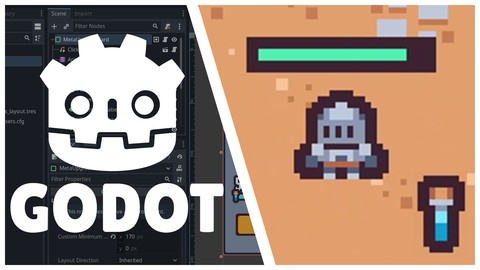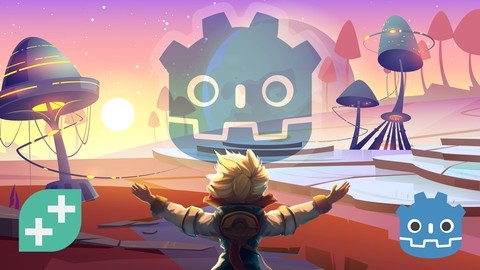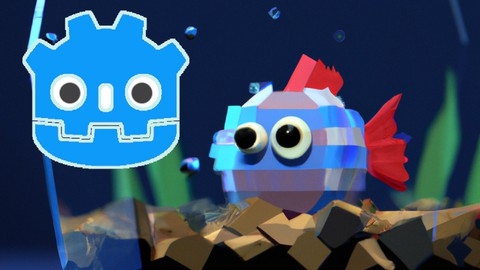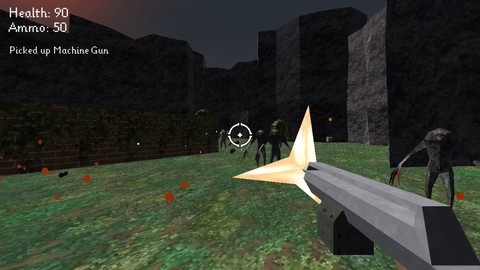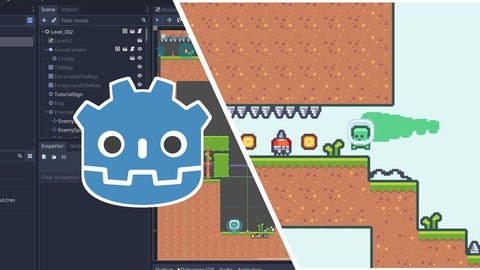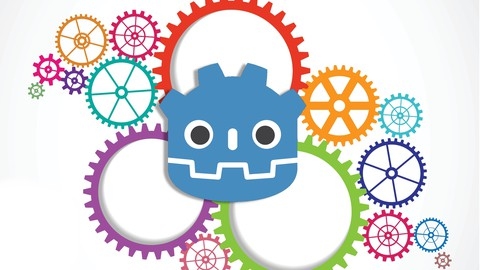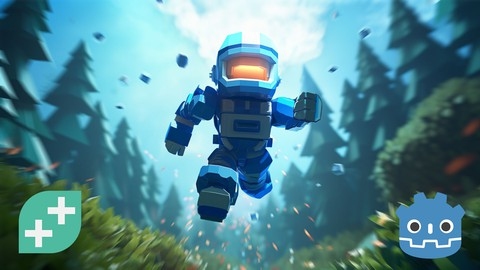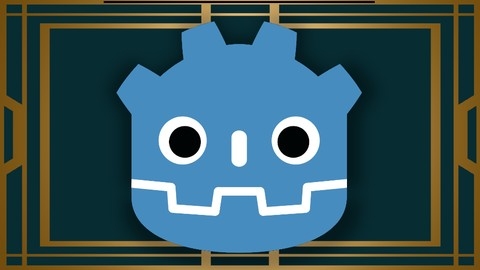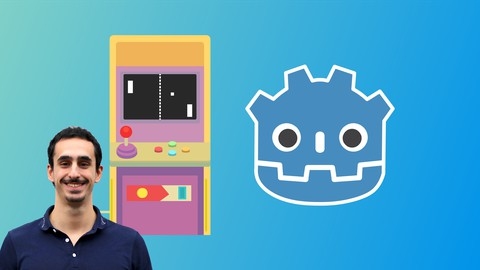Create a Complete 2D Survivors Style Game in Godot 4
You’ll start by setting up Godot and creating the player character, including movement and a camera following the player.
From there, you’ll build the core gameplay loop - creating enemies that spawn automatically, implementing combat abilities like a sword and axe, tracking player experience, and upgrading abilities.
You’ll also add health components for the player and enemies, so they can take damage.
The course doesn’t stop at just the basics.
You’ll improve the gameplay feel with experience drops, difficulty increases over time, and preventing enemies from spawning in invalid locations.
Visuals get an upgrade too - you’ll animate the player, enemies, and UI elements, add particle effects, and even implement a custom font.
Sound is crucial for immersion, so you’ll integrate sound effects throughout the game, from combat to UI interactions.
The course also covers adding music.
To polish the game, you’ll create main, options, and pause menus with transitions between scenes.
A meta-progression system lets players upgrade persistent stats between runs.
Finally, you’ll learn how to export the game for publishing.
Bonus lectures show how to extend the game further by adding new enemy types, abilities like an anvil attack, and meta-upgrades like health regeneration.
You’ll even fix a bug with enemy spawning.
With this course, you’ll gain experience in all aspects of building a complete 2D game in Godot 4 - from initial setup to final deployment.
The hands-on project-based approach ensures you learn by doing.
Complete Godot 2D: Develop Your Own 2D Games Using Godot 4
The course provides a comprehensive introduction to game development with Godot.
You will start by learning the fundamentals of the Godot interface, project setup, and basic concepts like nodes and scenes.
The first project, “Speedy Saucer,” will teach you about physics, instancing scenes, parent-child relationships, draw order, scripting basics like variables, functions, and control structures.
You’ll also learn about vectors, applying forces, handling input, camera control, creating levels, signals for resetting the game, parallax backgrounds, and text labels.
In the “Alien Attack” project, you’ll dive deeper into scripting, creating references to nodes, spawning enemies, collision layers, managing lives, scoring, UI elements, sound effects, particle effects, and path-based enemy movement.
The “Martian Mike” project covers animated sprites, boolean operators, updating animations based on state, creating hazards and power-ups using Areas, the AnimationPlayer node for animations, arrays, groups, for loops, tile maps with auto-tiling, scrolling backgrounds, changing scenes, implementing a timer, win screens, start menus, level design techniques, the singleton pattern for persistent objects like music players, and one-time sound effect playback.
Throughout the projects, you’ll learn essential programming concepts like variables, functions, control structures, data structures, and object-oriented programming principles.
The course emphasizes hands-on learning by building complete games while introducing new Godot features and programming concepts incrementally.
Jumpstart to 2D Game Development: Godot 4 for Beginners
This course helps you learn 2D game development using the Godot 4 engine.
You’ll start with an introduction to Godot and its core concepts like scenes, scripts, and inheritance.
Then, you’ll dive into programming fundamentals such as variables, operators, arrays, loops, dictionaries, functions, and classes.
The real fun begins when you start building games!
The first game you’ll create is a Flappy Bird clone called “Tappy Plane.”
You’ll learn how to set up the game scene, create the player plane, animate its flight, handle movement and collisions, spawn obstacles, manage scoring, and implement sound effects and parallax scrolling.
Next up is “Angry Animals,” a physics-based game where you’ll learn about RigidBody2D nodes, dragging and launching objects, and handling collisions.
You’ll also explore level selection, scoring, and persistence.
In “Memory Madness,” you’ll create a memory game and learn about image loading, tweening animations, level creation, and game logic implementation.
The course then takes you through the development of “Fox Antics,” a platformer game.
You’ll work with tile maps, player movement and states, enemy AI, shooting mechanics, power-ups, checkpoints, moving platforms, spikes, parallax backgrounds, camera shakes, and multiple levels.
Other games you’ll build include “Sokoban” (a puzzle game), “Space Ace” (a space shooter with enemy waves, power-ups, and upgrades), and “Do Not Mind Me” (a stealth game with AI patrolling, field of view, and shooting mechanics).
Throughout the course, you’ll learn about essential game development concepts like singletons, groups, signals, autoloads, layers and masks, navigation meshes, and more.
You’ll also learn how to deploy your games and work around common issues.
The course covers a wide range of game genres and mechanics, ensuring you gain a solid understanding of Godot’s capabilities and best practices for 2D game development.
How to Make a Retro Style 3D FPS in the Godot Game Engine
This course takes you through the process of creating a retro-style 3D first-person shooter (FPS) game in the Godot game engine.
You will start by setting up the game environment, including the scene, navigation meshes, lighting, and skybox.
Next, you will create the player character, implementing features like movement, mouse aiming, health management, and a weapon manager.
The course then dives into making various weapons, such as guns, a shotgun, a machete, explosives, and a rocket launcher.
You will learn to import 3D models, create weapon animations, add muzzle flashes, implement bullet hit effects, and animate the weapon manager.
Moving on, you will create enemies with features like hitboxes, state machines, health management, senses, movement, melee attacks, and ranged attacks like fireballs.
The course also covers creating blood sprays and gibs for added realism.
You will then learn to make weapon, ammo, and health pickups, as well as a pickup manager to handle their functionality.
The course also guides you through creating a player UI, including a restart message, health and ammo display, health effects, and pickup information.
Additionally, the course provides information on using sound effects and exporting your game.
It also includes a work-in-progress section on creating an FPS in the upcoming Godot 4 engine, covering similar topics like environment setup, player movement, health, weapon management, and various weapon types.
Create a Complete 2D Platformer in the Godot Engine
This course takes you step-by-step through the entire process of creating a polished 2D platformer, from the initial setup to the final export, ensuring you have a solid understanding of the Godot Engine and game development principles.
You will start by laying the foundation, setting up Godot and creating a rough player controller with basic movement.
The course then guides you through developing core mechanics like camera follow, player animations, coyote time, double jump, collectables, spikes, player death and respawn, enemies, and a player dash ability.
As you progress, you’ll learn to finalize the game mechanics by preventing player void death, implementing a coin counter, creating level UI with the BitPotion font, handling enemy respawns, changing levels, and designing a level complete UI.
The course doesn’t stop there - it dives into enhancing the game feel and polish with camera shake, player and enemy death animations, particle effects like dash trails and footsteps, adding tile variety and clouds, and creating more levels.
You will also build a main menu, screen transitions, pause menu, game complete screen, options menu with volume controls, and tutorial signs.
The course covers animating UI panels, player victory animations, and even customizing the mouse cursor.
Sound effects and music are integrated using audio buses and a random audio stream player.
Finally, you’ll learn how to prepare the game for distribution by fixing any remaining UI and sound issues and exporting the project.
Discovering Godot
You’ll start by getting familiar with Godot’s interface and then dive into creating your first game, “Loony Lips” - a word game that teaches you GDScript programming concepts like arrays, dictionaries, and JSON data.
Next, you’ll build a 2D platformer called “Hoppy Days” where you’ll learn to create physics-based characters, animated sprites, tiled levels, and parallax backgrounds.
You’ll also implement game mechanics like spikes, coins, NPCs with different behaviors, and special effects.
The course then guides you through making “Heist Meisters”, a top-down stealth game.
You’ll work with lighting, line-of-sight algorithms, path-finding for guards, interactive objects like keypads and computers, and create a full tutorial system.
Switching to 3D, you’ll develop “Cubedude Kickabout” - a local multiplayer soccer game.
You’ll set up a 3D environment, create physics-based player controllers, implement scoring and resetting mechanics, and add visual effects and audio.
Finally, in “Food Fight”, you’ll build a third-person shooter where you’ll learn the AnimationTree node, mouselook controls, projectile mechanics, and populate the scene with furniture, bystanders, and robots.
Throughout the course, you’ll gain hands-on experience with core Godot features like nodes, scenes, physics, animation, GUI, audio, and more - equipping you with a solid foundation to create your own games.
Godot 3 Complete Developer Course - 2D and 3D
You’ll start by setting up Godot and learning its scripting language, GDScript.
The course covers variables, conditionals, loops, arrays, and functions, providing a solid foundation.
Next, you’ll dive into building games, beginning with a simple number guessing game.
You’ll learn about the project layout, displaying messages, handling player input, and using nodes and signals.
The course then progresses to more complex games like “Tree Puncher,” where you’ll create trunks, animate the player, detect collisions, and spawn objects.
The “Space Attack” game will teach you how to create moving backgrounds, handle player and enemy movement, implement shooting mechanics, and spawn enemy formations.
You’ll also learn to add audio to enhance the gaming experience.
In the “Platform Jump” game, you’ll work with platforms, gravity, cameras, particle effects, moving platforms, menus, themes, and saving player data.
The course culminates with the “Hammer Time” game, where you’ll explore 3D development, lighting, materials, scoring systems, and creating bomb scenes.
Throughout the course, you’ll gain hands-on experience with essential game development concepts like collision detection, spawning objects, animating characters, implementing scoring systems, and creating menus.
The course also covers exporting your games for various platforms, including Android and HTML.
Complete Godot 3D: Develop Your Own 3D Games Using Godot 4
This course covers the fundamentals of creating 3D games using the Godot game engine.
You will learn by building three complete projects from scratch - a rocket game called “Project Boost”, a tower defense game called “Barbarian Blaster”, and a retro first-person shooter named “Robo Rampage”.
In Project Boost, you’ll start with the basics like setting up scenes, scripting player movement, and using physics.
Then you’ll progress to more advanced topics like collision detection, respawning, loading levels, tweening hazards, particles, customizing visuals, and exporting your game.
The Barbarian Blaster section teaches you to use the GridMap node for level design, create enemy paths with Path3D, implement health systems, use raycasting for mouse input, build and aim turrets, spawn projectiles and enemies, create UI elements, manage difficulty curves, and implement victory conditions.
Finally, Robo Rampage covers first-person movement, aiming the camera, drawing custom reticles, advanced jumping mechanics, navigation meshes for AI, equipping the player with weapons, recoil, damage systems, particle effects, subviewports, shaders for visual effects, ammo management, pickups, zooming, building interior levels, animation trees, and environment polish.
Throughout the projects, you’ll work with concepts like Constructive Solid Geometry, projectile motion, visual shaders, UI, tweening, source control, and more.
The course provides hands-on experience in using Godot’s nodes, scripting, and editor tools to create immersive 3D experiences.
Godot Getaway: The Godot Course
The course starts by setting up the game design, covering the player experience and file formats.
Then, you’ll dive into multiplayer networking, creating lobbies and using RPCs for communication.
Next up is vehicle physics, using Godot’s VehicleBody and VehicleWheel nodes to get cars driving around.
You’ll code movement for local and remote players.
After that, the real fun begins - procedurally generating an entire city!
Using GridMaps and algorithms, you’ll create maze-like streets, buildings of varying heights, and neighborhoods with different vibes.
To make the city feel alive, you’ll populate it with props like parked cars, billboards, traffic cones, hydrants, street lights, dumpsters, and even scaffolding.
The city will have distinct neighborhoods and cafes.
There’s even a zeppelin flying overhead!
The gameplay revolves around teams delivering money while evading cops.
You’ll set up teams, minimaps, grid references, beacons, money pickups, and crime tracking.
Sirens will wail as cops chase criminals.
Players will have customizable billboards and cars with different paint jobs.
To set the mood, you’ll use AudioBus to add dynamic music that adapts to neighborhoods.
The “Polish” chapter covers visual effects like chase cams, day/night cycles, exhaust particles, and distance fading.
You can even tweak settings in an options menu.
Finally, the fancy lobby lets players admire their custom cars before jumping into the Getaway!
Godot Beginner Course - Learn How To Make Games
You’ll start by learning how to set up the Godot editor and navigate its interface.
The course then dives into the fundamentals of working with nodes and scenes, which are the building blocks of games in Godot.
One of the key concepts covered is instancing, which allows you to create multiple copies of a scene or node.
You’ll also learn how to write scripts using GDScript, Godot’s built-in scripting language.
The course covers essential scripting topics like accessing nodes, handling input, and working with delta time for smooth movement.
Signals, a crucial part of Godot’s event system, are introduced, allowing you to connect different parts of your game logic.
To solidify your understanding, you’ll build a complete Pong game from scratch, implementing features like ball movement, scoring, and resetting the game.
The course then guides you through creating a more complex game called “Star Shooter.”
You’ll learn how to import assets, create player and enemy scenes, implement shooting mechanics, and add various gameplay elements like enemy spawning, damage handling, and a death zone.
Throughout the project, you’ll also learn how to create a heads-up display (HUD) for displaying scores and lives, integrate sound effects and music, and build menus like the main menu and game over screen.
Additionally, the course covers adding visual effects like particle systems and explosions, enhancing the overall game experience.
By the end of the course, you’ll have a solid understanding of the Godot engine and the skills to create your own games.
You’ll be able to work with nodes, scenes, scripting, signals, and implement various gameplay mechanics.
The course provides a hands-on approach, allowing you to learn by building two complete games from start to finish.
